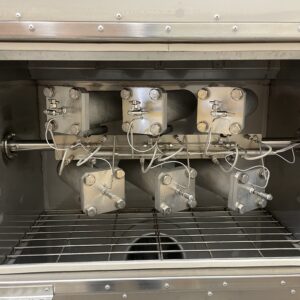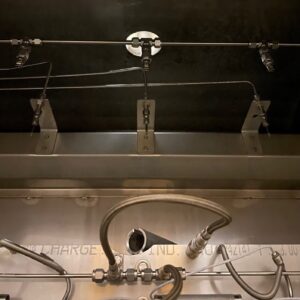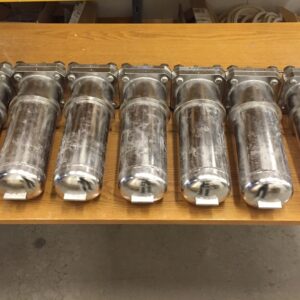DESCRIPTION
The CRS Autoclave Oven is a user-friendly machine, designed for multi sample production in a convenient and efficient way. Often a workhorse for many laboratories or institutions that operates it the machine is primarily used for pulping, but also widely employed for bleaching.
Focus is on high throughput, repeatability, and reliability – while maintaining an operator-friendly working environment, an intuitive interface, and an ergonometric mode of hands-on operation.
The number of reaction vessels are six and they are mounted in an equal way on a shaft rotating inside the oven. The mounting is standardized to allow for many different types of autoclaves to be fitted and used in the oven – various types are autoclaves are called “series”. Although CRS always recommends ordering the oven with our standard EN1.4404/316L general purpose 3L series, additional series of other autoclaves can be ordered in parallel or added later. Such autoclaves can be made in different sizes or other materials.
If autoclaves are fitted with top valve and quick connection it is possible to pressurize and depressurize them while mounted inside the oven, although this requires a manual operator intervention.

The autoclaves are mounted on the shaft in an angled fashion to give a swirling motion inside when the shaft is rotated. This is to ensure optimal mass transfer. A high-speed air stream is circulated around inside the oven, heated by a powerful electrical heater to achieve satisfactory ramp rates of temperature. Water sprays can facilitate rapid cooling.
To monitor precisely what is happening inside the autoclaves, every vessel has its own temperature sensor. An array of water sprays can further control the individual autoclave temperatures to make sure they experience similar conditions – something that the nature of a hot air stream and the small differences of the content of each vessel would otherwise give rise to.

The CRS Autoclave Oven is controlled by a cutting edge Beckhoff PLC system, allowing operation from any PC over a web interface. The system allows for remote trouble shooting and diagnostics, as part of the CRS commitment to easily serviceable machinery.
WHAT CAN IT BE USED FOR
Typical applications include:
- Mill quality control support
Often this machine is operated partly in a supporting role to one or more mills, as a practical way of checking impact of raw materials, liquors etcetera to stock. - Wood research
Forestry divisions use this machine to test wood properties, such as when screening clones or when evaluating of foresting practices. - Laboratory pulp producer
Laboratories that need pulp that is produced under reliable and known conditions, for other downstream research purposes, such as bleaching or washing, often use this machine to supply the stock. - Large number sample analysis
In any application where the sheer number of samples needed is large, this machine is often used, even when it would not be the primary or optimal choice. Typically, this machine can therefore have a supporting role to recirculation systems, because its sample production rate can be tenfold. - Pulping where circulation is not necessary or difficult
If the raw material is such that circulation is difficult, as with straw, or circulation is not feasible due to an extremely low liquor to wood ratio required, this machine is typically used. - Initial experimental checks of new process and odd experiments
Institutions that operate more advanced machinery, such as larger pilot digesters, use this machine as a first level testbed, to optimize the use of the more expensive and time-consuming machinery.
HISTORY
The history of the CRS Autoclave Oven goes back over 20 years, when a replacement to the commonly used oil-baths was in demand. Undergoing many developments and improvements ever since, learning both from customer feedback and own experience, the current design is now in generation 5.
Note that some newer features can be fitted to older generations as upgrades, please inquire for more information on what is possible in case you are operating an older version and interested in upgrading.

Technical data
Below are listed some key technical data for this machine, valid for the current generation (5).
Construction
| 180 x 140 cm (height 200 cm) 300 x 250 cm |
| < 700 kg < 800 kg |
| EN1.4301/304 EN1.4404/316L EN1.4404/316L standard series, custom possible |
Operation
| Up to 190 C |
| Up to 230 C |
| Positive up to 2 C/min; Negative down to 2 C/min Positive up to 3 C/min; Negative down to 1 C/min |
| 1 – 20 Rpm (by recipe) |
| 10 kg (typically around 3 – 3.5 L) |
Requirements
| Single operator |
| 25 kW max load |
| Required Optional (typically Oxygen) |
